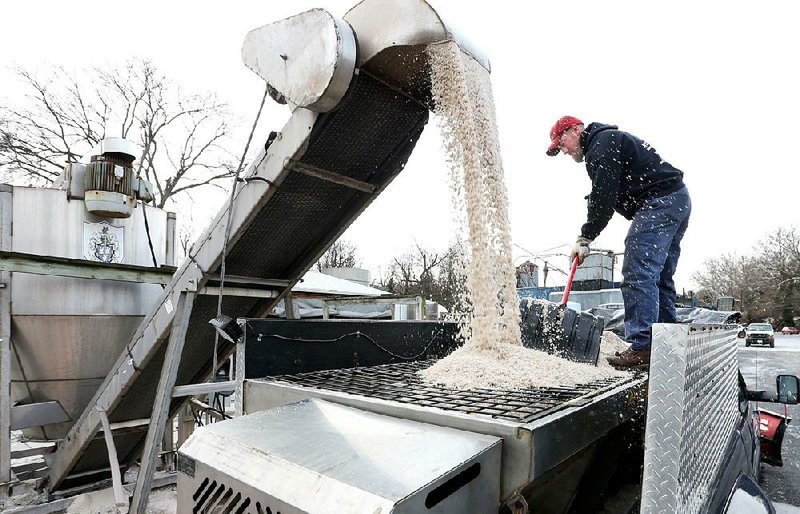BOISE, Idaho -- A winter storm has swept aside two long-standing snow records in Boise, Idaho, and is moving east as turbulent weather lined up across much of the country Thursday with watches covering large parts of the South.
For Idaho, the National Weather Service said snow accumulating for several weeks reached 15 inches Thursday in Boise and broke the previous snow-depth record of 13 inches set twice in the mid-1980s.
The service also said the 6.5 inches of snow that fell Wednesday eclipsed the 1951 record of 3.2 inches.
Meteorologist Jay Breidenbach with the National Weather Service in Boise said an Arctic air mass in Idaho combined with moist air off the Pacific Ocean is driving the storm east, producing snow in Colorado and New Mexico.
He said the storm will continue moving east and "could bring a wintry mix to some southern cities like Atlanta."
Winter storm watches Thursday covered large parts of Georgia, Alabama and the Carolinas ahead of the storm system that threatens to spread a mix of rain, sleet and snow across the region.
Forecasters warned that even a thin layer of ice could make weekend travel treacherous on highways just north of the Gulf Coast all the way to the East Coast.
"Certainly any snow down your way is significant because of potential disruptions to local traffic and all the activities throughout the Southeast," said Mike Schichtel, lead forecaster at the federal government's Weather Prediction Center in College Park, Md.
But for California, it's rain, not snow that is causing problems. In Southern California, Thursday morning commuters were warned of slick roads as a series of rainstorms moved through. Counties in central California were under a flash flood warning until 1 p.m. Thursday.
But Thursday, heavy snow and strong winds raised the avalanche danger in much of Colorado's high country.
Some areas have seen several feet of new snow while others received less than a foot by Thursday morning, the Colorado Avalanche Information Center, reported. Two passes were closed so crews could reduce the chance of avalanches.
In Utah, an overnight winter storm dumped as much as 9 inches of snow on parts of the state's northern region and forced at least half a dozen school districts to cancel or delay classes Thursday.
The National Weather Service reported that Salt Lake City International Airport received nearly 5 inches of snow overnight, with other pockets receiving 3-4 inches.
With a threat of freezing rain in parts of the Deep South, Schichtel urged residents to be on guard and avoid driving if conditions deteriorate. It takes only a thin layer of ice to create havoc for all types of vehicles, he said.
"If you have a four-wheel-drive vehicle and you think you're safe, you're not," Schichtel said of icy conditions. "Take it very seriously and adjust your travel plans accordingly. Even if the reports are for very minor icing, I would avoid the roads."
Light to moderate snow could extend from central Alabama into southeastern Virginia late today into early Saturday, the Weather Prediction Center said in an advisory.
Some parts of North Carolina could receive 4 inches or more of snow, and there's a "slight risk" of 8 inches or more of snow in eastern North Carolina and southeast Virginia, according to the advisory.
By Thursday afternoon, the National Weather Service had issued a winter storm warning for northeast Georgia, the upstate of South Carolina, and central and western North Carolina, effective from this evening to early Saturday afternoon.
The forecast called for up to 6 inches of snow for parts of Georgia, South Carolina, and the piedmont and foothills of North Carolina, which could make some roads impassable and cause power failures from snow accumulating on tree limbs and power lines.
The warning for central North Carolina called for a mixture of snow and sleet with up to 5 inches and as much as 7 inches from the central piedmont to the northern coastal plain.
Shoppers had already begun their pilgrimage to local grocery stores across North Carolina to stock up on the customary purchases of bread and eggs. Sherrill Suitt Craig went shopping at a grocery store near her home, only to leave for a store several miles away because her initial stop was too crowded.
More than two-thirds of West Virginia's counties sent students home early from public schools as the storm moved in Thursday.
And with forecasters saying as much as 2 inches of snow and sleet could fall in central Alabama by Saturday morning, some Birmingham-area systems canceled today's classes and sporting events as a precaution.
Snow also is possible in Atlanta, where snow and ice in past storms have jammed freeways. The National Weather Service projects that 2 inches of snow could fall in Atlanta, with slightly higher amounts in some suburbs.
Information for this article was contributed by Colleen Slevin, Michelle Price, John Antczak, Tom Foreman Jr., Jay Reeves and John Raby of The Associated Press
A Section on 01/06/2017
